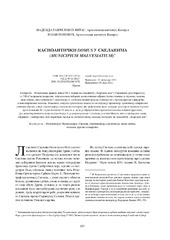Приказ основних података о документу
Late antique domus in Skelani (Municipium Malvesiatium)
| dc.creator | Gavrilović-Vitas, Nadežda | |
| dc.creator | Popović, Bojan | |
| dc.date.accessioned | 2022-05-10T11:25:17Z | |
| dc.date.available | 2022-05-10T11:25:17Z | |
| dc.date.issued | 2015 | |
| dc.identifier.issn | 0350-0241 | |
| dc.identifier.uri | http://rai.ai.ac.rs/handle/123456789/230 | |
| dc.description.abstract | During June and July 2014, at the site of Zadružni Dom in Skelani, archaeological investigations of the late antique building were carried out, whose rooms were first discovered in the course of archaeological excavations in 2008. The building has a rectangular base, of a northeast-southwest orientation, with the discovered part measuring 20.90 x 30.90 m. What is distinguishable within the asymmetrical base is an entrance, along with eleven rooms, two of which have apses, and a peristyle, i.e. an inner courtyard with a roofed corridor surrounding it which connects all the rooms of the building. During the archaeological excavations, entrance thresholds and extremely well preserved mortar floors with mortar skirting were noted in most rooms, along with traces of fresco painting on the walls and mosaic floors, executed in the opus tesselatum technique, observed in several rooms, the peristyle and the encompassing corridor. The discovered mosaic fragments are decorated with geometric motifs in the form of a swastika, a Solomon’s knot, a square, a rhomboid, overlapping circles, etc. and floral motifs of ivy and petals, as well as a double braid motif. Small but, unfortunately, fragmented pieces of a mosaic with a figural representation were discovered in the central part of the peristyle, while the mosaic in room K was decorated with a motif portraying the winged head of Medusa. Two construction phases were noted, an older and a younger, with the walls, which were two Roman feet wide and built from dressed stone, and the older mortar floor belonging to the older construction phase, and the second, younger construction phase comprising mosaics, fresco painting, the younger mortar floor and two furnaces. Contemplating the planimetry of the building, one gets the impression of the rooms being divided between two parts - public and private, whereby the public part of the building would be located near the main entrance hall and would comprise rooms A, B, C, D and F, with mortar floors and traces of fresco painting on the walls. The other, possibly private, part of the building would include five rooms G, H, I, J and K and the inner courtyard. Rooms I, J and K had floor and wall heating, while rooms G and H had an arched apse and possibly functioned as a reception hall and/or a stibadium. The hallway with mosaics, which flanks the inner courtyard, was most likely roofed. Traces of burning in the north-western corridor testify to the destruction of the building in a fire. Based on the architectural elements and the traces of fresco painting and mosaics in the building at the site of Zadružni Dom in Skelani, it can be deduced that this is a late antique building which can roughly be dated to the period between the end of the 3rd and the mid-4th century AD, and whose lavish decoration implies that it was owned by an affluent resident of Skelani from the aforementioned period. | en |
| dc.publisher | Arheološki institut, Beograd | |
| dc.rights | openAccess | |
| dc.rights.uri | https://creativecommons.org/licenses/by-nc-nd/4.0/ | |
| dc.source | Starinar | |
| dc.subject | Municipijum Malvezacijum | |
| dc.subject | Skelani | |
| dc.subject | stratigrafija | |
| dc.subject | arhitektura | |
| dc.subject | kasna antika | |
| dc.subject | mozaici | |
| dc.subject | fresko-slikarstvo | |
| dc.title | Late antique domus in Skelani (Municipium Malvesiatium) | en |
| dc.type | article | |
| dc.rights.license | BY-NC-ND | |
| dc.citation.epage | 220 | |
| dc.citation.issue | 65 | |
| dc.citation.other | (65): 197-220 | |
| dc.citation.rank | M24 | |
| dc.citation.spage | 197 | |
| dc.identifier.doi | 10.2298/STA1565197G | |
| dc.identifier.fulltext | http://rai.ai.ac.rs/bitstream/id/107/227.pdf | |
| dc.type.version | publishedVersion |


